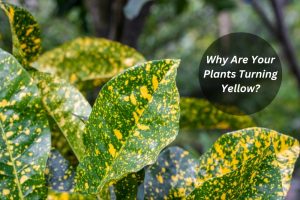If you’ve observed your cherished greenery undergoing a subtle shift to a pale yellow hue, it’s a situation that demands attention. The appearance of yellowing leaves can often act as a distress signal from your plants, and comprehending the underlying factors is essential for nursing them back to their former health. In this comprehensive guide, we will delve into the primary causes behind the appearance of those troublesome yellow spots on a plant. Moreover, we will provide practical solutions to aid your plants in regaining their vitality and flourishing once more.
What are the most common causes of yellow leaves on plants?
Yellow leaves are like an SOS message from your plants, signalling that something is amiss in their environment. Here are some of the most common culprits behind this botanical distress call:
- Overwatering or underwatering – Plants are particular about their water intake. Too much or too little can lead to yellowing leaves. If you notice the soil is consistently soggy, your plant may be drowning. Conversely, if it’s bone dry, it’s likely parched. Adjust your watering routine accordingly.
- Poor drainage – Proper drainage is essential to prevent waterlogged roots. Ensure your pots have drainage holes, and use well-draining soil. When water stagnates, it can suffocate the roots, leading to yellow leaves.
- Nutrient deficiencies – Similar to how humans need a well-rounded diet, plants also depend on essential nutrients for their well-being. When crucial elements like nitrogen, iron, or magnesium are deficient, it can result in the emergence of yellow leaves. It’s advisable to contemplate the use of a well-balanced fertilizer to provide your plants with the nourishment they require.
- Pest infestations – Unwanted guests like aphids, spider mites, or whiteflies can suck the life out of your plants, literally. Their feeding habits can lead to discoloured leaves. Furthermore, inspect your plants regularly and use organic or chemical remedies as needed.
- Fungal infections – Fungi love moisture, and they can infect your plants, causing yellow spots and mouldy growth. Remove affected leaves, improve air circulation, and consider a fungicide to curb the spread.
- Temperature stress – Plants have temperature preferences, and extremes can result in yellowing. Some are sensitive to cold drafts, while others can’t tolerate scorching heat. Ensure your plant is in a suitable location for its species.
- Root rot – Root rot is a stealthy assassin that attacks from below the soil. It’s often caused by overwatering and poorly drained soil. Moreover, if your plant’s roots are mushy and brown, it may be too late to save it.
How to identify the cause of yellow leaves on your plants
Now that you’re familiar with the usual suspects, it’s time to play detective and pinpoint the exact cause of the yellowing. Follow these steps to uncover the mystery:
- Inspect the leaves: Take a close look at the yellow leaves. Are they uniformly yellow, or are there spots, streaks, or discolourations? The pattern can provide clues.
- Check the soil: Stick your finger an inch or two into the soil. Is it dry, damp, or waterlogged? Soil moisture can indicate overwatering or underwatering.
- Examine the roots: Gently remove the plant from its pot and examine the roots. Healthy roots should be firm and white. If they’re brown, slimy, or have a foul odour, root rot might be the culprit.
- Look for pests: Use a magnifying glass to inspect the leaves for tiny critters or webs. Pests like spider mites can be hard to spot with the naked eye.
- Review care habits: Reflect on your plant care routine. Have you been consistent with watering, fertilising, and providing the right environment?
By scrutinising these factors, you’ll be well on your way to identifying the cause of the yellowing leaves.
How to fix yellow spots on plants
Once you’ve uncovered the cause of the yellowing, it’s time to take action. Here’s how to address some common issues:
- Adjust your watering:
- For overwatering, let the soil dry out before watering again. Consider repotting your plant in well-draining soil.
- If underwatering is the problem, increase your watering frequency. Ensure the soil is thoroughly moistened each time.
- Correct nutrient deficiencies:
- Choose a balanced, water-soluble fertiliser suitable for your plant type.
- Follow the recommended dosing instructions on the fertiliser packaging to avoid over-fertilisation, which can lead to other problems.
- Combat pest infestations:
- Use insecticidal soap or neem oil to treat your plant. Ensure you cover both sides of the leaves and repeat the treatment as necessary.
- Isolate-infested plants to prevent the pests from spreading.
- Tackle fungal infections:
- Remove affected leaves and dispose of them far from your healthy plants.
- Improve air circulation by spacing your plants appropriately.
- Use a fungicide as a last resort, following the instructions carefully.
- Mitigate temperature stress:
- Relocate your plant to a more suitable location if it’s exposed to extreme temperatures.
- Shield your plant from drafts and direct sunlight.
- Address root rot:
- Trim away the affected roots using sterile scissors or pruning shears.
- Repot your plant in fresh, well-draining soil and a clean pot.
Remember that patience is key when nursing your plant back to health. It may take several weeks for new, healthy growth to replace the yellow leaves.
What to do if your plant has yellow spots
Yellow spots on your plant’s leaves can be a sign of various issues, from pest damage to fungal infections. Here’s what to do if your plant is spotted:
- Identify the cause: Examine the yellow spots on a plant closely. Are they raised, sunken, or discoloured? This can help determine the cause.
- Treat pests: If you suspect pests, follow the same steps mentioned earlier for pest infestations.
- Address fungal infections: For fungal issues, gently remove the affected leaves and follow the fungal infection treatment steps.
- Check for sunburn: Yellow spots on a plant can also result from sunburn. If your plant has been exposed to intense sunlight, move it to a shadier spot.
- Improve air circulation: Ensure your plant has adequate air circulation to prevent moisture buildup, which can lead to fungal problems.
- Maintain consistent care: Stick to a regular watering and fertilising schedule, and keep an eye on your plant for any signs of improvement or further deterioration.
Remember, a little TLC can go a long way in helping your plant recover from yellow spots.
How does mulching prevent yellow spots on plants?
Mulching is not just a gardening aesthetic; it’s a practical way to promote plant health and prevent the dreaded yellow spots on your beloved greenery. Let’s delve into how mulching can be a game-changer for your plants.
- Moisture retention – Mulch acts as a natural moisture regulator. It helps retain soil moisture by reducing evaporation, ensuring a consistent level of hydration for your plants. This is especially beneficial for preventing both under and overwatering, which can lead to yellow leaves.
- Temperature regulation – Mulch also acts as an insulating barrier, shielding your plant’s roots from extreme temperature fluctuations. Furthermore, by maintaining a more stable root zone temperature, mulch can help prevent stress-induced yellowing caused by temperature extremes.
- Weed suppression – Weeds can compete with your plants for essential nutrients and water, potentially causing nutrient deficiencies and yellowing leaves. Moreover, mulch creates a barrier that inhibits weed growth, allowing your plants to thrive without this competition.
- Disease prevention – Certain fungal infections thrive in soil splashed onto plant leaves during rain or watering. Mulch acts as a protective shield, preventing soil from splashing onto the leaves and reducing the risk of fungal diseases that cause yellow spots.
- Nutrient enrichment – Over time, organic mulches break down and enrich the soil with valuable nutrients. This ensures your plants have access to a steady supply of essential elements, reducing the chances of nutrient-related yellowing.
How to keep your plants healthy and prevent yellow leaves
Prevention is often the best cure. To keep your plants consistently vibrant and green, follow these tips:
- Water wisely: Learn your plant’s specific water needs and provide appropriate hydration. Use a saucer under the pot to catch excess water and prevent root rot.
- Choose the right soil: Use well-draining soil tailored to your plant type. This prevents waterlogged roots and enhances nutrient absorption.
- Fertilise responsibly: Use a balanced fertiliser at the recommended intervals. In addition, avoid over-fertilising, which can lead to nutrient imbalances.
- Regularly inspect your plants: Check your plants for signs of pests or diseases regularly. Also, early detection allows for prompt treatment.
- Maintain adequate humidity: Some plants, like tropical varieties, thrive in higher humidity. Consider using a humidifier or misting your plants to create the right environment.
- Place your plants strategically: Position your plants in locations that suit their light and temperature preferences. Read up on the specific needs of each plant species you own.
- Repot as needed: When your plant outgrows its current pot, repot it into a slightly larger one with fresh soil.
By following these guidelines, you can create a nurturing environment for your plants, reducing the risk of yellow leaves and other issues.
Conclusion
In summary, the presence of yellow leaves on your plants is a clear signal that something needs attention in your green oasis. By identifying and addressing the common causes such as overwatering, poor drainage, nutrient deficiencies, pests, fungal infections, temperature stress, and root rot, you can nurse your plants back to health and restore their vibrant green glory. Remember to play detective by closely inspecting your plants, checking the soil, examining the roots, looking for pests, and reviewing your care habits. Additionally, don’t forget the power of mulching, which can help prevent yellow spots by regulating moisture, and temperature, suppressing weeds, preventing diseases, and enriching the soil. Lastly, by implementing these strategies and maintaining consistent care, you’ll keep your plants thriving and yellow leaves at bay, ensuring a flourishing indoor garden for years to come.
If you’ve noticed your cherished plants displaying distress signals in the form of yellow leaves, it’s time to take action. All Green Gardening & Landscaping is here to help you diagnose the issues plaguing your green companions and provide expert solutions to restore their vitality. Don’t let yellow leaves be a cause for concern; let us guide you on the path to lush, healthy plants. Contact us today to schedule a consultation and give your garden the care it deserves. Together, we’ll ensure your plants flourish once more.

